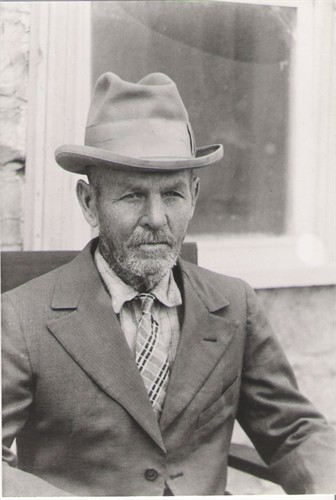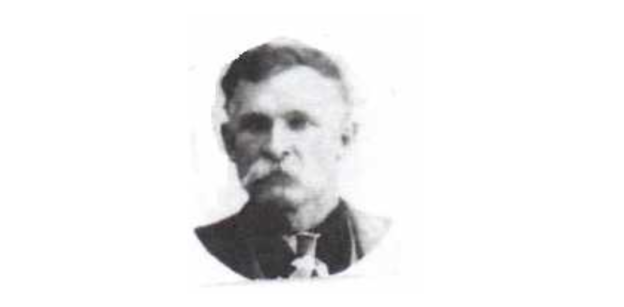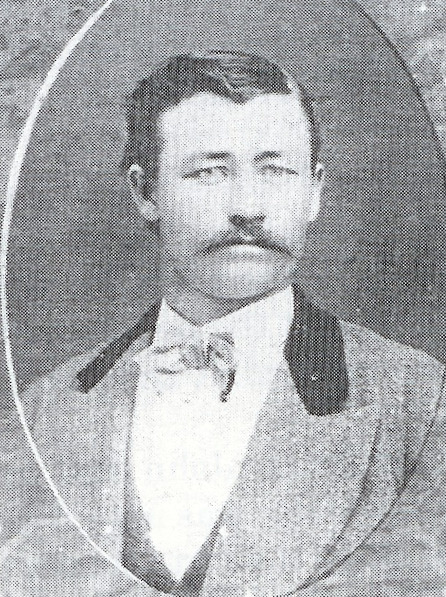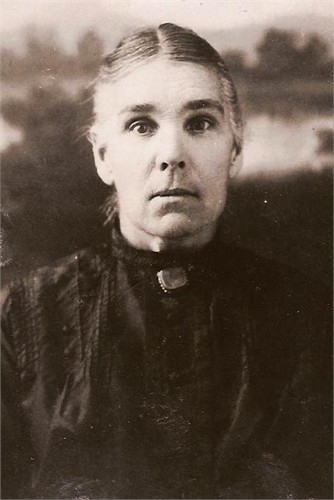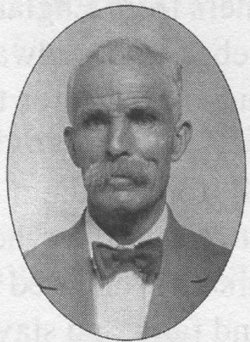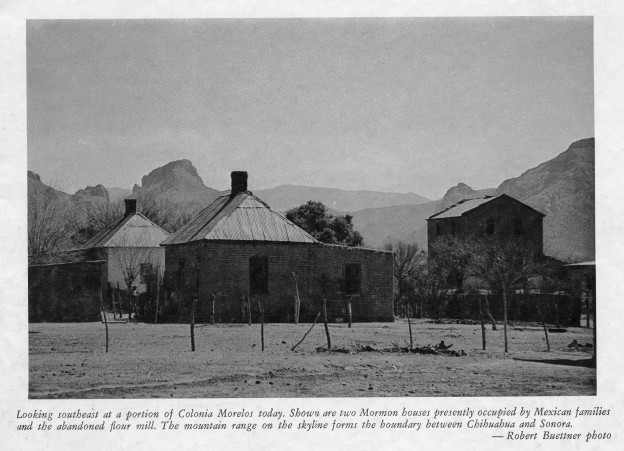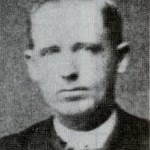Harry “M” Payne
(1857 – 1940)
Harry “M” Payne was born on December 3, 1857 in Cassup, Durham, England. His parents were Edward Payne and Emma Powell, who were both of English descent and bother were converted to the Church prior to their marriage on September 16, 1854.
This young couple was not satisfied nor happy with the conditions under which they had to work and live, and in their hearts was a longing and desire to gather with the Saints in the Salt Lake Valley. Quietly, they began to make plans and to pray that the way might be opened that they would be able to emigrate.
Harry’s father Edward, was employed in the coal mines, but working conditions were poor and pay was meager. Each miner was bound to his employer by a contract, which made it impossible to improve working conditions or seek other employment. About this time, Edward and three other men, who were members of the Church, decided to break their contracts with the mines. They felt justified in doing this because they were working only half-time.
Consequently, these four men quietly sold what household possessions they could spare to help raise sufficient funds to take them to America. They hoped to find employment and save enough money to send for their families. The men took passage on a sailing vessel and upon arrival in New York were offered employment in the coal mines in Fallbrook, Pennsylvania. This was during the early part of 1863 when the Civil War was being fought in the United States. Therefore, laborers were scarce and the wages high. Edward, with his three companions, decided to do contract work instead of day labor.
In the fall of 1863, Edward, Harry’s father, sent for his wife and four children— George, Harry “M”, Lucy, and Thomas. He also sent passage money for his father-in-law, George Powell. When this group was finally able to leave England, they were joined by the families of the other men, who were with Edward in Pennsylvania. They secured passage on the same sailing vessel and arrived safely in New York on Christmas day 1863. One of the men working in Pennsylvania met the party in New York and took them to Fallbrook, where they joined in a most happy reunion. They Payne family spent the remainder of the winter and the next spring there.
In July, Harry’s mother, brothers, sister, and grandfather left Fallbrook and continued their journey toward Zion. They went by ox team to St. Joseph, Missouri, and from there up the Missouri River to Winter Quarters companies were formed and they began the long, arduous journey across the plains.
The Emigration Fund, sponsored by the Church, afforded the Payne and Powell families the opportunity to borrow money to finance their journey across the plains. There was an unusually large number of Saints from England at this time at Winter Quarters, and the transportation from the regular companies was found to be inadequate. Fortunately, there was a large freight outfit leaving Winter Quarters at the same time, so the belongings of 375 of the group were piled on top of the loaded freight wagons.
To more clearly understand the circumstances, I quote fhe following from Harry’s lips: “My mother and her family, her father and his family, my mother’s sister and her family, making a group of 16 souls in all, were assigned to one freight wagon.” Whe we think fo their baggage, and all the earthly possessions of 16 people being loaded on the top of the wagon, we can readily conclude that all who were physically able had to walk. Grandmother Powell was ill and rode all of the way. The smaller children rode part of the way and occasionally they were allowed to ride the oxen.
On their journey to Zion, Harry and the family saw their first Indians. An Indian chief approached the company and asked for flour, promising that if he were granted the request, the company would have buffalo meat awaiting them on the road the next day. The following day, the came upon Indians who were waiting with three or four dressed buffalo to pay the debt incurred for flour.
This was a treat because, prior to this, the menu had consisted of bread, salt bacon, gravy and small portions of dry foods. They gathered berries and dried them for future use. Usually, the Saints in Utah sent help to travelers by sending dried fruit, squash, beans and any other food.
When nearly halfway to Utah, Thomas, the baby, two years of age, took sick. He died on August 22, 1864, as they camped at Bitter Creek. As the train left camp the next morning, the wagon carrying the sorrowing family lingered behind, while they dressed the child, sewed him up in a sheet, as there was no material for a coffin, and then laid him in a grave, the end of a wagon gate placed over him.
Welcome was the day when they came in sight of the first settlements and people met them with loads of vegetables and fresh foods. The freight wagon which had been used by the Payne’s was going to Heber City, so the three families stayed with the wagon and settled temporarily in Heber. Here, they stayed in the school house for a few days and neighbors brought in milk, butter, and fresh vegetables. So they feasted sumptuously for a time. Only two weeks after the family arrived, Harry’s mother gave birth to a new daughter, Elizabeth.
The next fall, Harry’s father purchased a farm. With the help of his boys, they tried to make a living, but the fourth year of farming was marked by the grasshopper plague. As farming was the only means of support, Edward walked 50 miles to a railroad construction camp where he obtained employment. Later he returned to Heber City and moved his family to Coalville, where they worked in the mines. Harry began working in the mine two months before he was eleven years old. He worked 12 hours per day for .75 cents. His job was to lead a mule which pulled the coal cars. Every other week he had to work at night. The next summer, 1869, the East and West were joined by rail with the completion of the Union Pacific to Salt Lake City.
The family spent the next six years working in the mines, but grew tired of it, so they moved to Glenwood, Utah, where the boys could work on a farm. Shortly after their arrival there, the Church commenced the United Order. Edward told his boys that he was going to join the Order, but they could choose for themselves. By this time, Harry was 18 years old and he joined the Order also. His father divided the property, giving him a pair of oxen and a cow, which he turned into the Order.
Harry had admired a lovely young lady, Helen Amelia Buchanan. Their friendship grew into courtship, and they made plans for marriage. Late in February of 1878, they started for the St. George Temple, 200 miles away, to be married for time and eternity. Another young couple, also to be married, traveled with them. As they were still living in the Order, they were provided a team, feed and wagon, five dollars in cash and 100 pounds of flour to give as a donation to the Temple. It took them a week to make the trip to St. George and on March 6, 1878, they were married and the following day started their homeward journey. A small adobe house with a dirt roof was their first home and what was left of the five dollars set them up in housekeeping. Harry’s assignment in the Order was to haul timber from the mountains and for this purpose he was provided with a team of young oxen and a wagon. After five years the United Order was closed. Harry remained until his termination and drew his equity with which he bought a city lot, a team of horses and a wagon. Very shortly he built a well-constructed, two-room, adobe house, which was their first real home.
Their first child, Harry Lorenzo, was born January 18, 1879. Two years later on January 8, 1881, a daughter, Elnora, blessed their home. At this time Harry found it necessary to leave home to find work, so he went to Marysvale and obtained a job making railroad ties. While there, on April 2, 1882, a call came to fill a mission to what was then known as the Northern States Mission. After his departure, his wife taught school for one year and also worked as a telegraph operator to support herself and her two children. Owning to conditions at the time, the missionaries were required to spend only two summers and one winter, as it was almost impossible to do much tracting during the winter months.
Harry returned from his Mission in December, 1883 and in April of the next year, he moved his family to Rabbit Valley. Here they intended to make their new home, but five days after their arrival, Harry received a letter from President John Taylor calling him to preside as Bishop over the Aurora Ward of the Sevier Stake of Zion. He was only 26 years of age when his family moved to Aurora and there, on April 11, Harry was sustained as Bishop.
At this time polygamy was being practiced and Harry, like other Church leaders, was requested to live this principle. He talked the matter over with his wife Helen, as he did not wish to shirk his responsibility. They looked about for someone to help them live this higher law, and after much deliberation and prayer were led to a young woman by the name of Ruth Curtis. Harry broached this subject to Ruth’s parents and obtained their consent to take their daughter in plural marriage. He then went to Ruth about the matter, gained her consent, and began to court her. Their courtship was short of necessity secret, because of the opposition of outside forces. In order to obey the principle, Harry and Ruth traveled 400 miles round trip from Aurora to St. George by team and wagon to be married in the temple on March 3, 1886.
Harry, Helen and Ruth had lived under trying circumstances because of the crusade against polygamy, but were true to the principles in which they so firmly believed. On June 15, 1887, a daughter, Edna, was born to Harry and Ruth, and as the deputy marshals were constantly seeking to arrest anyone with two wives, Harry took employment up in the mountains in a timber camp. Here he remained until he received a letter from his wife Helen, asking him to come home for short time. He not been home long before Helen gave birth to a son, Junius Edward, on October 3, 1887. A day or two later, Harry’s brother Edward, came to warn him that he would soon be arrested. Harry went immediately to the President of the Stake for counsel and was advised, “You can do more good in the mission field than in the penitentiary.” With the recommended from the Stake President, he reported to Apostle Franklin D. Richards, and was soon on his way to Great Britain. He remained there until October 1889.
On October 30, 1889, Harry returned from his mission and was promptly arrested by S. F. Mount, deputy marshal, for “unlawful cohabitation.” This term meant that a man acknowledged his plural wife whether he was living with her or not. The charge carried a penalty of six months imprisonment and a $300 fine. On February 24, 1890, Harry and his two wives appeared in court. The two ladies were called to witness before a grand jury, but refused to testify against her husband. Nevertheless, sufficient evidence was obtained to get an indictment, so on March 6, Harry was sentenced to six months imprisonment and a $300 fine.
While serving his sentence, Harry decided he would move to Mexico, for he had no intention of learning his plural family. He was released a month early for good behavior. Immediately they prepared for the moved to Mexico. President Wilford Woodruff issued the Manifesto on September 24, 1890, in which he advised the Saints to obey the laws of the land. It was made plain by Church Authorities that the only way in which they could continue to live with their families was to go to a country where there was no law against a plurality of wives. Harry began at once to prepare to move. At last things were ready and their wagon, plow, farm implements, supplies, furniture, bedding, stoves and other household items were are all loaded into a freight car on the Denver-Rio Grande Railroad and the team forces was put in one end of the same car. Harry went along on this trained to care for his animals. The families were scheduled to follow on a passenger train to Deming, New Mexico. Friends met the Paynes in Deming with a team and wagon to assist them in making their way to the colonies in Mexico. They arrived there October 25, 1891.
In Colonia Dublan, Harry and his families were very active in both civil and church affairs. They were poor at this time and had to forgo many pleasures, but managed to sustain themselves. The first year was the hardest, and an example of their poverty is related by second wife, Ruth. Their menu consisted mainly of bread and gravy. Once in a while, they would get a handful of beans and would have a treat of bean soup. When the Payne’s first arrived in Dublan, they lived in a small two-room house. It was here that Ruth’s second daughter, Lucinda, was born on February 12, 1892. Harry’s first job in Dublan was helping to make molasses, and his pay was also in molasses. When winter came, he took a job about 6 miles west of town at Jackson’s flour mill, where he was able to secure flour enough to feed his families.
In the spring of 1892, he rented a small farm from Philip H. Hurst and planted wheat crop, but it proved to be an unusually dry year. The family desperately needed that crop, so they fasted and prayed for rain. The Lord, in answer to their place, sent the “dews of Heaven” to save the wheat and keep it growing another day. In the fall of 1892, the families moved into a house on the main street of town. It was a very cold, open, rough-sawed lumber house. On December 8 18, 1892, Helen’s 4th son and 6th child, George, was born. It was snowing at the time of his birth and it was necessary to hang canvas around her bed to keep out the cold wind. In the spring of 1893, Harry found the farm that he could by he could raise the down payment. Anson B. Call, a friend and a neighbor, offered assistance to close the deal by lending him $25.
Harry set about to provide better home for his families. During the next four years, he built to homes and a granary to care for his week. In 1897, Harry purchased a city block in the townsite, and the new home was built for Ruth on the southwest corner. A large tent was pitched on the Northwest corner for Helen. This located the Payne families just across the corner from church and school. Later, another home was erected where the tent had been pitched, and living conditions were much improved for both families. Harry was a man of action, full of vigor, resourceful and determined. These characteristics, along with his faith and testimony of the Gospel, made him an outstanding leader wherever he went.
His first church appointment after arriving in Dublan, Mexico was as an assistant Sunday School teacher. Following this, a Ward was organized in Dublan late in 1891 with Winslow Farr as the Bishop, Frederick G. Williams, First Counselor, Philip H. Hurst Second Counselor, and Harry “M” Payne as Ward Clerk. Shortly after this, Harry was chosen as a regular teacher in the Sunday School. Approximately 2 years later he was sustained as Superintendent and served for several years. Harry was quite musically inclined and talented and singing. Shortly after his arrival in Dublan, he was asked to help lead the singing in the meetings. There is no piano or organ to accompany the singing, so he used a tuning fork to get the pitch for the songs. He served on the first High Council, which was before the Juarez Stake was organized, and served through the administration of President Anthony W. Ivins. During the years of his Stake assignments, he was faithful, and visited all the Wards and Branches by team and wagon or on horseback. In 1894, Harry was called as President Of the Young Men’s Mutual Improvement Association. He was also called to do home missionary work. He traveled 60 miles to the north to visit Colonia Diaz, 150 miles to the west to visit Morelos and Oaxaca, and 90 miles to the southwest to Chuhuichupa. Harry’s eldest son, Harry L., Was the first missionary to leave Dublan by train. He went to the Southern States Mission in the summer of 1897.
In Mexico, the chief industry was farming and, besides caring for his farm, Harry took the job as water master on one of the canals. This job lasted from 1903 to 1912. In overseeing the jurisdiction of water for 1,500 acres of farmland and 300 city lots, much of his traveling for this job was done on the bicycle. Besides this work, he went on the week thresher every season from 1891 to 1912.
Early in the first decade of the new century, there began to be political disturbances in Mexico. The colonists were not alarmed. The rumblings of revolution constantly grew louder and soon actual war broke out in the country. This caused much concern for the safety of all American citizens living south of the border. As the majority of the colonists had retained their American citizenship, they were told to take no part in the Revolution. After much counseling by Authorities, it was decided that all Mormons who were willing to leave their home should return to United States. Harry, with other men, was requested to go on the train that was to take the women, children and older people to the states, and to look after their safety and welfare.
The people of Dublan all gathered at the Union Mercantile to meet the train which was to take them to the States. When the train finally arrived it was loaded almost a capacity with Saints from other colonies, so the Dublan people had to wait for another. In the meantime it started to rain and the dismal weather seemed to add a spirit of sadness. When an extreme came, it was still raining and as the people were getting into the cars, one dear old Englishman said, “Ah, even the ‘evens are weaping with us.” When the trains caring the women and children arrived in El Paso, Texas, the problem of housing caring for them proved to be a real challenge. City officials and immigration officers were very helpful and cooperative in doing what they could to make everyone as comfortable possible. One of the Twelve Apostles, Anthony W. Ivins, who had been the former stake president in Mexico, was sent to El Paso to represent the church in this hour crisis.
All were advised to make their own decisions as to whether they would remain in the States or return to Mexico. Most of the Payne family returned to Utah, leaving behind forever their entire accumulations of 20 years. Many of the refugees settled temporarily along the Rio Grande River, but were desirous of finding a place to establish themselves permanently. Martin L. Harris, who and also settled there, started first Sonora, Mexico, in the summer of 1913. He passed through Lordsburg, he saw Mr. Frank Stowell, a former colonist, who persuaded him to go to Richmond and look at the Valley along the Gila River. Mr. Harris was impressed, so after his return from Sonora he aroused the interest of other refugees in looking at the Valley with intent to make a settlement.
A committee of three men was appointed to look over the proposition. They made the trip immediately after Christmas of 1914, and upon their return the committee, Frederick W. Jones, John B. Jones, and Peter Mortensen, gave a most favorable report. In February 1915, Frederick W. Jones and Samuel A. Brown were sent from the Rio Grande, Peter Mortensen and Joseph Mortenson of Deming accompanying them to meet with Mr. Virden and Mr. Cherry in Duncan, Arizona. They made arrangements to purchase a tract of land belonging to Mr. Burton and Mr. Cherry. As soon as the people began moving into the Gila area, 40 acres were surveyed and divided into blocks for lots and streets, with added acreage for a school. Two lots were reserved for a church and park. About six months after the townsite was laid out, award was organized and the name of the town was changed from Richmond to Virden.
On February 24, 1918, Harry was ordained a Patriarch in this ordination took place at Layton (now Safford), Arizona under the hands of Orson F. Whitney, a member of the Council of the Twelve Apostles. He held this office until his death. Here Harry was still active in the Sunday School, and before his service terminated, he had worked over 50 years in this one organization. This picture and an account of some of his work in the Sunday school appeared in an issue of The Instructor magazine, under the caption, “A Veteran Sunday School Teacher.” In his article, he expressed his confidence that the Sunday School would keep growing and doing much good. He also stated that this organization had done him a great deal of good in broadening his view of the Gospel and giving him an opportunity to serve.
Harry “M” Payne enjoyed a long and active life, but the years always take their toll. He buried his loving wife, Helen, on January 3, 1936. Gradually his shoulders became stooped and his hair turned a beautiful snowy white. But his spirit only grew more stalwart and his noble influence on family and friends more broad and deep. One of Harry’s greatest joys was to be with his children and grandchildren. He was always willing to share some interesting story, experience, or song at family gatherings. On his 81st birthday, December 3, 1938, his oldest son Harry Lorenzo, known as H.L., paid his father a wonderful tribute when he read a poem and sang the song “That Silver-Haired Daddy of Mine” over the radio from the Safford, Arizona station. In the evening, his children and grandchildren gathered at his home to express her love and appreciation and to wish him health and happiness. In January 1940, he suffered a slight stroke and was cared for with love and tenderness by his devoted wife, Ruth, with the assistance of his sons and daughters who were living nearby. Death came peacefully, on February 28, 1940, in his 83rd year.
Myrtle Jones Nelson, granddaughter
Stalwarts South of the Border Nelle Spilsbury Hatch page 519


